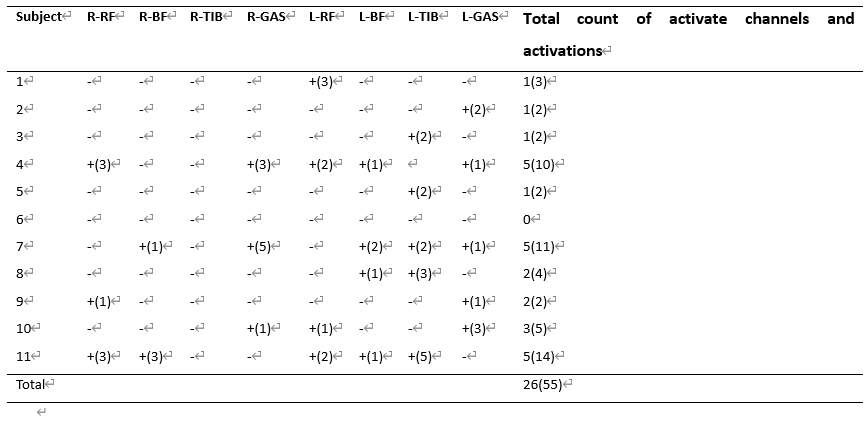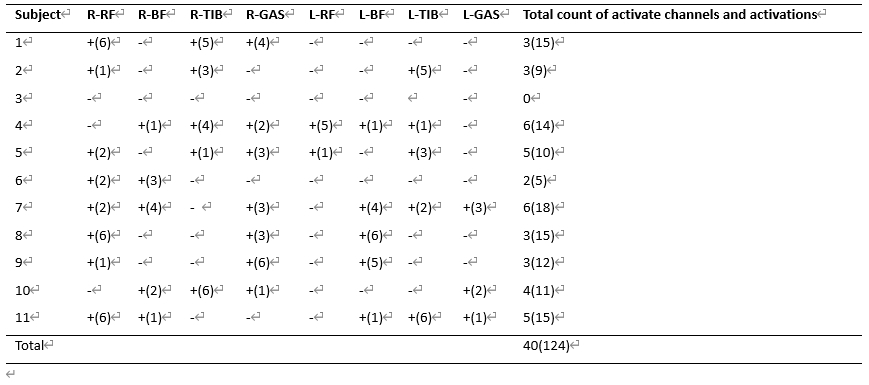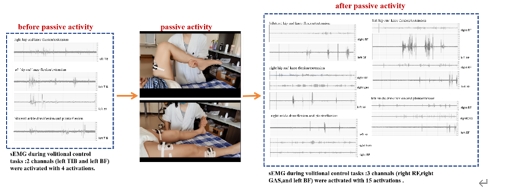NRR:北京航空航天大学李晓光团队提出:被动活动可对完全脊髓损伤患者残余运动控制能力产生积极的影响
撰文:萧演清,高明明,何泽佳,郑佳,白洪铭,杨朝阳,饶家声,宋桂芸,宋伟,李晓光
严重的脊髓损伤会导致感觉、运动和自主功能永久丧失,显著改变生活方式[1]。根据美国脊髓损伤协会的分类,脊髓损伤可分为完全(complete)损伤和不完全(incomplete)损伤两大类[2]。然而,研究表明,完全性脊髓损伤患者在独立执行意志任务或参与涉及非瘫痪肌肉的活动时,可通过电生理测试检测出残余的运动激活[3-6],这被称为不完全性(discomplete,不同于incomplete)脊髓损伤[7, 8]。执行意志控任务期间的表面肌电图是检测下肢残余通路连接的一种敏感方法[9, 10]。有研究提出,为了产生有效的步进,必须调节脊髓回路到一个最佳的兴奋性水平[11]。当脊髓回路调整到一种"生理状态"时,即使缺乏传统的局部感觉输入,肌肉活动仍可通过自主提示启动。这种生理状态可通过脑干刺激、硬膜外刺激、药理促进和运动训练等方法进行调节[12-14]。其中,步态模式化训练可诱导任务特异性的感觉和运动活动模式,并优化神经系统内的活动依赖性神经可塑性[15, 16]。被动活动可改变运动神经元的内在电生理特性,并恢复脊髓运动环路的整体兴奋性。这种训练可恢复突触前抑制和超极化水平。周期性活动可激活脊髓回路和相关肌肉,促进调节性神经过程[17, 18]。与上述运动训练对脊髓回路的积极影响相似的是,在北京航空航天大学李晓光团队一项完全性脊髓损伤患者的表面肌电研究中,意外地观察到了对完全脊髓损伤患者进行短暂的被动活动后可导致执行意志任务时肌电通道激活的增加,且这些特征发生得足够频繁(研究已采用),值得进一步探索。如果这一现象得到证实,它可能对具有残留少量脊髓轴突的患者的评估有益,因为它增强了检测对残余神经控制的敏感性,而无需进行密集的步态模式化训练来增强意志任务时的肌电激活[9]。
最近李晓光等在《中国神经再生研究(英文)》(Neural Regeneration Research)上发表了题为“Passive activity enhances residual control ability in patients with complete spinal cord injury”的研究。该研究发现运动完全性脊髓损伤患者在被动活动后,执行意志控制任务期间激活的表面肌电通道数量和激活频率显著增加,表明脊髓回路的兴奋性提高。表面肌电图振幅的累积均方根有增加趋势。这些发现表明,短暂的被动活动可增强肌电检测任务时的自主肌肉激活的能力,从而提高评估完全性脊髓损伤患者残余控制能力的敏感性。
李晓光等假设,慢性运动完全性脊髓损伤患者在接受被动下肢运动后,脊髓运动回路兴奋性提高,从而导致在意志控制任务期间表面肌电图激活的改善。研究结果可见,在被动活动前,11例患者在意志控制任务期间的26条肢体上总共表现出55次活动。而在经历被动活动后,激活的肢体数量增加到40条,激活总共达到124次(表1,表2和图1)。且统计学分析结果显示,被动前后激活的肌肉通道数量以及激活次数存在显著差异。同时研究发现,持续约20 min的短期被动活动可显著增强临床诊断为完全脊髓损伤的患者的意志任务时的表面肌电图通道的数量和激活频率。与被动活动前相比,每个任务的均方根值都有所增加,但差异无显著性意义,这表明被动运动对脊髓回路兴奋性的影响不足以明显提高肌电幅度,但可增强整体激活频率。这些发现表明,短暂的被动活动可以适度增强脊髓回路的兴奋性,从而有助于改善对瘫痪肌肉的自主控制能力,证实了研究假设。
表1被动活动前的激活肌肉通道数量和激活情况(表源:Xiao et al., Neural Regen Res, 2025)

表2被动活动后的激活肌肉通道数量和激活情况(表源:Xiao et al., Neural Regen Res, 2025)

图1在被动活动前,在意志控制任务中分别激活2个通道(左TIB和左BF),共激活4次,经过20min的被动活动后,在意志控制任务中3个通道(右RF、右GAS和左BF)被激活,共激活15次。(图源:Xiao et al., Neural Regen Res, 2025)

运动训练被认为可增强脊髓的顺序抑制机制,包括相互抑制和突触前抑制,同时也可增强行走过程中反射兴奋性的调节,如比目鱼肌的长时间拉伸反射[19-23]。研究表明,脊髓损伤后,比目鱼肌在站立和摆动阶段持续延长过程中H反射的调节受到损害,且与正常对照相比,反射振幅显著增加[24, 25]。一种涉及特定任务治疗策略的干预,包括交替拉伸和缩短的自行车训练,可增强肌肉延长过程中H反射的调节。无论是在有体重支持和手动辅助的跑步机上行走,还是在固定辅助自行车力量计上训练,都涉及下肢肌肉有节奏的缩短和延长模式。
有研究发现,虽然类步态训练和自行车训练都显著提高了地面行走速度,但只有自行车训练组显示出在不完全脊髓损伤患者中H反射抑制的明显减少[26]。另一项研究发现,在自愿激活比目鱼肌时,配对反射抑制减少或停止。因此认为,在需要主动肌肉放电的任务背景下,配对反射抑制可能没有功能上的重要性或相关性。相比于自行车训练,类步态运动训练条件下的肌肉激活增强可能导致对反射抑制变化的敏感性降低[27]。李晓光等指出,骑自行车涉及相对有规律、持续和重复的屈伸交替任务,不涉及额外的姿势控制成分。这种结构化和受控的任务提供了更一致的输入信息,增强了重新组织输入信息的潜力。此次实验的被动任务类似于自行车训练,需要简单和重复的交替任务,而不需要认知参与。因此,提供了一致的传入信息,促进了传入信息的重组。相比之下,行走是一项复杂的任务,需要姿势控制,髋、膝和踝关节的相对协调以及对正确脚步摆放的注意。在行走过程中,对脊髓的注意力和步行控制需求可能会减弱交替屈伸输入到神经系统的一致性[26]。
交替的被动下肢运动可能通过增强脊髓回路的生理状态来改善肌肉活动的自主控制。可能的机制包括增加反射抑制和降低反射兴奋性,这已被证明可以改善脊髓损伤患者的踝关节控制,并涉及到5-羟色胺等神经递质的调节[28]。脊髓损伤后,损伤脊髓水平以下的5-羟色胺受体对5-羟色胺变得过敏,可能是由于内源性5-羟色胺水平不足[29]。动物实验表明,自行车训练可能增加腰髓中5-羟色胺的释放,从而增加反射抑制[30, 31]。此次研究中所观察到的结果可能与上述的机制有关。
然而此次研究观察到部分患者的某些肌肉通道的激活只在特定任务中出现,或可能在开始的指令时出现,但在后面的指令中消失,或者反之亦然。它们也可能在被动运动之前出现,被动运动后减弱或消失。例如,在患者3左侧胫骨前肌在被动运动之前被激活了2次,但在被动运动后观察不到了激活。在患者8左侧胫骨前肌在被动运动之前被激活,被动运动之后消失,但整体激活在被动运动后增加。其他研究也报道了类似的现象,即参与者无法维持或重现这种活动[30]。
这些结果表明脊髓损伤后,脊髓回路表现出流动性和不确定性。一项研究使用非负矩阵分解和独立成分分析来分析脊髓损伤患者残余脊髓运动回路的协调模式[32]。结果显示,与健康受试者相比,脊髓损伤患者辅助步行过程中识别到的协调模式数量呈现更大的变异性和复杂性。通过脊髓外刺激成功康复的个体的研究结果表明,缺乏明显的协调模式,这表明通过脊髓外刺激恢复行走功能并不依赖于脊髓生成的协调模式的正常化[32]。李晓光等指出,脊髓损伤患者中动力模块的数量变化以及时空模式的改变表明失去的脊髓输入对脊髓节律和模式生成回路产生了广泛影响[32]。此次研究结果与既往研究结果相似,支持了脊髓回路的激活模式存在广泛的变异性。
尽管研究已发现在短暂的被动活动后,意志控制任务时的表面肌电图通道数量和激活频率增加,但表面肌电图振幅没有实质性变化。这表明短期被动运动对脊髓回路的激活影响有限。然而,这些结果对临床实践有重要贡献,提高了利用表面肌电图检测脊髓损伤患者残余运动控制的敏感性,有利于帮助确定损伤的完整性。研究未提供支持将被动活动与其他康复训练相结合改善患者康复结果的证据,因此需要进一步研究。此外,研究中采用的被动活动方案可能与其他方案有所不同,时间参数对脊髓回路的影响也不确定。建议在未来的研究中扩大样本规模,以提高研究的可靠性和推广性。基于研究结果,提出了临床启示,包括增强评估残余控制能力的敏感性以及在被动关节活动后进行主动自愿训练等。这些启示为未来研究提供了指导,并为康复实践提供了信息,有助于制定针对增强残余运动控制能力和优化康复结果的有针对性康复计划。
原文链接:https://doi.org/10.4103/NRR.NRR-D-23-01812
参考文献
[1] Post M, Noreau L. Quality of life after spinal cord injury. J Neurol Phys Ther. 2005;29(3):139-146.
[2] Kirshblum SC, Burns SP, Biering-Sorensen F, et al. International standards for neurological classification of spinal cord injury (revised 2011). J Spinal Cord Med. 2011;34(6):535-546.
[3] Awad A, Levi R, Waller M, et al. Preserved somatosensory conduction in complete spinal cord injury: Discomplete SCI. Clin Neurophysiol. 2020;131(5):1059-1067.
[4] Calancie B, Molano MR, Broton JG. Abductor hallucis for monitoring lower-limb recovery after spinal cord injury in man. Spinal Cord. 2004;42(10):573-580.
[5] Dimitrijevic MR, Faganel J, Lehmkuhl D, et al. Motor control in man after partial or complete spinal cord injury. Adv Neurol. 1983;39:915-926.
[6] Mckay WB, Lim HK, Priebe MM, et al. Clinical neurophysiological assessment of residual motor control in post-spinal cord injury paralysis. Neurorehabil Neural Repair. 2004;18(3):144-153.
[7] Sherwood AM, Dimitrijevic MR, Mckay WB. Evidence of subclinical brain influence in clinically complete spinal cord injury: discomplete SCI. J Neurol Sci. 1992;110(1-2):90-98.
[8] Wahlgren C, Levi R, Amezcua S, et al. Prevalence of discomplete sensorimotor spinal cord injury as evidenced by neurophysiological methods: A cross-sectional study. J Rehabil Med. 2021;53(2):jrm00156.
[9] Grahn PJ, Lavrov IA, Sayenko DG, et al. Enabling task-specific volitional motor functions via spinal cord neuromodulation in a human with paraplegia. Mayo Clin Proc. 2017;92(4):544-554.
[10] Santamaria AJ, Benavides FD, Saraiva PM, et al. Neurophysiological changes in the first year after cell transplantation in sub-acute complete paraplegia. Front Neurol. 2020;11:514181.
[11] Edgerton VR, Courtine G, Gerasimenko YP, et al. Training locomotor networks. Brain Res Rev. 2008;57(1):241-254.
[12] De Leon RD, Tamaki H, Hodgson JA, et al. Hindlimb locomotor and postural training modulates glycinergic inhibition in the spinal cord of the adult spinal cat. J Neurophysiol. 1999;82(1):359-369.
[13] Gerasimenko YP, Lavrov IA, Bogacheva IN, et al. Formation of locomotor patterns in decerebrate cats in conditions of epidural stimulation of the spinal cord. Neurosci Behav Physiol. 2005;35(3):291-298.
[14] Liu J, Jordan LM. Stimulation of the parapyramidal region of the neonatal rat brain stem produces locomotor-like activity involving spinal 5-HT7 and 5-HT2A receptors. J Neurophysiol. 2005;94(2):1392-1404.
[15] Edgerton VR, Roy RR, Hodgson JA, et al. Potential of adult mammalian lumbosacral spinal cord to execute and acquire improved locomotion in the absence of supraspinal input. J Neurotrauma. 1992;9 Suppl 1:S119-128.
[16] Muir GD, Steeves JD. Sensorimotor stimulation to improve locomotor recovery after spinal cord injury. Trends Neurosci. 1997;20(2):72-77.
[17] Beaumont E, Houlé JD, Peterson CA, et al. Passive exercise and fetal spinal cord transplant both help to restore motoneuronal properties after spinal cord transection in rats. Muscle Nerve. 2004;29(2):234-242.
[18] Reese NB, Skinner RD, Mitchell D, et al. Restoration of frequency-dependent depression of the H-reflex by passive exercise in spinal rats. Spinal Cord. 2006;44(1):28-34.
[19] Boorman G, Becker WJ, Morrice BL, et al. Modulation of the soleus H-reflex during pedalling in normal humans and in patients with spinal spasticity. J Neurol Neurosurg Psychiatry. 1992;55(12):1150-1156.
[20] Boorman GI, Lee RG, Becker WJ, et al. Impaired "natural reciprocal inhibition" in patients with spasticity due to incomplete spinal cord injury. Electroencephalogr Clin Neurophysiol. 1996;101(2):84-92.
[21] Faist M, Dietz V, Pierrot-Deseilligny E. Modulation, probably presynaptic in origin, of monosynaptic Ia excitation during human gait. Exp Brain Res. 1996;109(3):441-449.
[22] Sinkjaer T, Toft E, Hansen HJ. H-reflex modulation during gait in multiple sclerosis patients with spasticity. Acta Neurol Scand. 1995;91(4):239-246.
[23] Yang JF, Fung J, Edamura M, et al. H-reflex modulation during walking in spastic paretic subjects. Can J Neurol Sci. 1991;18(4):443-452.
[24] Phadke CP, Wu SS, Thompson FJ, et al. Comparison of soleus H-reflex modulation after incomplete spinal cord injury in 2 walking environments: treadmill with body weight support and overground. Arch Phys Med Rehabil. 2007;88(12):1606-1613.
[25] Trimble MH, Behrman AL, Flynn SM, et al. Acute effects of locomotor training on overground walking speed and H-reflex modulation in individuals with incomplete spinal cord injury. J Spinal Cord Med. 2001;24(2):74-80.
[26] Phadke CP, Flynn SM, Thompson FJ, et al. Comparison of single bout effects of bicycle training versus locomotor training on paired reflex depression of the soleus H-reflex after motor incomplete spinal cord injury. Arch Phys Med Rehabil. 2009;90(7):1218-1228.
[27] Stein RB, Estabrooks KL, Mcgie S, et al. Quantifying the effects of voluntary contraction and inter-stimulus interval on the human soleus H-reflex. Exp Brain Res. 2007;182(3):309-319.
[28] Manella KJ, Roach KE, Field-Fote EC. Operant conditioning to increase ankle control or decrease reflex excitability improves reflex modulation and walking function in chronic spinal cord injury. J Neurophysiol. 2013;109(11):2666-2679.
[29] Li X, Murray K, Harvey PJ, et al. Serotonin facilitates a persistent calcium current in motoneurons of rats with and without chronic spinal cord injury. J Neurophysiol. 2007;97(2):1236-1246.
[30] Calancie B, Molano MR, Broton JG. EMG for assessing the recovery of voluntary movement after acute spinal cord injury in man. Clin Neurophysiol. 2004;115(8):1748-1759.
[31] Gerin C, Becquet D, Privat A. Direct evidence for the link between monoaminergic descending pathways and motor activity. I. A study with microdialysis probes implanted in the ventral funiculus of the spinal cord. Brain Res. 1995;704(2):191-201.
[32] Sun SY, Giszter SF, Harkema SJ, et al. Modular organization of locomotor networks in people with severe spinal cord injury. Front Neurosci. 2022;16:1041015.


